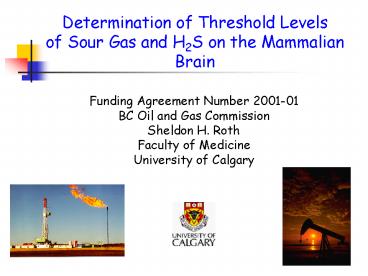Determination of Threshold Levels
1 / 28
Title:
Determination of Threshold Levels
Description:
to evaluate the differences of effects between H2S alone and as a component of ... inhibition of respiratory enzymes (cytochrome oxidase, carbonic anhydase) confirmed ... –
Number of Views:27
Avg rating:3.0/5.0
Title: Determination of Threshold Levels
1
Determination of Threshold Levels of Sour Gas
and H2S on the Mammalian Brain
Funding Agreement Number 2001-01 BC Oil and Gas
Commission Sheldon H. Roth Faculty of
Medicine University of Calgary
2
Objectives of Study
- to determine threshold levels of hydrogen
sulphide (H2S), sour gas and H2S/organic compound
mixtures - i.e. the Lowest Observable Adverse Effect Levels
(LOAELs) and the No Observable Adverse Effect
Levels (NOAELs) - to evaluate the differences of effects between
H2S alone and as a component of sour gas on in
vivo and in vitro mammalian central nervous
systems (CNS)
3
Hydrogen Sulphide (H2S)
- extremely toxic gas
- environmental industrial pollutant
- produced by variety of human and natural
processes - produced endogenously in mammals
4
Hydrogen Sulphide
- colourless
- heavier than air
- flammable
- characteristic rotten egg odour
- odor threshold 0.5 ppb
- olfactory fatigue gt 100 ppm
- ATSDR 1999
- H2S Health Research Risk Assessment Symposium
2000
5
H2S exposure
- one of the leading causes of sudden accidental
death in the workplace - affects many organ systems (broad spectrum
toxicant) - effects dependent on concentration, duration and
rate of exposure - organs with high O2 demand - most susceptible
6
Broad spectrum effects of H2S
- nervous system (brain)
- lung
- heart
- reproductive developing systems
- eye
- metabolic systems
- smell (olfactory)
7
Dose Response of H2S
Roth Env Epidemiol Toxicol 1999
8
Effects of H2S (low level exposure)
- eye, nose throat irritation
- headache, sinus, etc
- nausea
- hoarseness, cough
- nasal congestion
- shortness of breath
- stress
- drowsiness
- Schiffman
- H2S Health Research Risk Assessment Symposium
2000
9
Effects of H2S exposure on the nervous system
(brain)
- mental depression
- irritability
- loss of memory
- lethargy
- dizziness
- loss of appetite
- fatigue
- headache
memory
Fundamentals of Neuroscience 1999
10
hippocampus
- functions of the hippocampus
- memory storage
- cognitive function
- sensory processing
- voluntary movements
Amaral Witter, 1989
11
Recording from hippocampus
placement of stimulating recording electrodes
PS amplitude of population spike
12
Methods
- prepare rat hippocampal slices
- place slices in recording chamber
- activate excitatory synaptic inputs to CA1
pyramidal neurons - record field potentials (PS) of CA1 neurons
- apply H2S gas (in nitrogen)
- analyze data using custom software
13
Monitor
Interscan Corporation 4000 Series Compact
Portable Analyzer 0-1999 ppb 1 ppb
resolution electrochemical voltammetry sensor
14
control experiments nitrogen
15
Exposure to 50 ppm H2S
16
Exposure to 25 ppm H2S
25 ppm H2S
17
18
Exposure to 1 ppm H2S
1 ppm H2S
19
20
500 ppb H2S
21
Dose response curve - H2S
22
Inhibition of Respiratory Mechanisms
cytochrome c oxidase whole brain IC50 0.13 µM
Nicholson et al J Toxicol Environ Health A 1998
23
J Toxicol Environ Health A 1998
24
Conclusions
- long-lasting synaptic enhancement occurs
following exposure to low levels of H2S - effects appear to be concentration-dependent
- inhibition of respiratory enzymes (cytochrome
oxidase, carbonic anhydase) confirmed - effects may account for symptoms such as anxiety
and cognitive impairment
25
Acknowledgements
- Investigators
- Ron Bennington
- James Brooks
- Russell Nicholson (SFU)
- Lisa Partlo
- R.S. Sainsbury
- Barbara Skrajny
- Lisa Strosher
- Steven Ip
- Ricardo Bonafine
- Peter OBrien (U of T)
- D.P. Archer
- Funding
- BC Oil Gas Commission
- Medical Research Council of Canada
- Alberta Heritage for Medical Research
- University of Calgary
26
Future Experiments
- H2S experiments in ppb range
- S. Ip
- Sour gas experiments
- S. Ip
- whole animal (in vivo) studies
- Dr. R. Bonafine
- further studies on respiratory enzymes
- Dr. P. OBrien University of Toronto
27
Sour Gas
28































